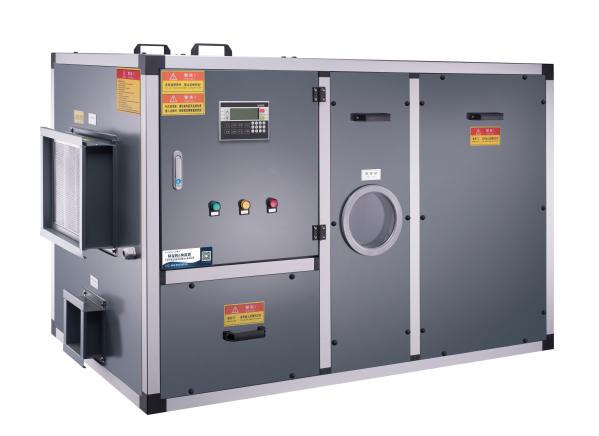
In the production process in the glass industry, humidity is very important to the production process. The production efficiency and quality of glass are closely related to humidity. Especially in the glass industry, the general process requirements are: temperature t=20 -26 ℃, relative humidity φ≤30%, this kind of occasion can only be achieved by using a combined rotary dehumidifier.

There are mainly the following three typical dehumidification styles:
1. Economic model
Principle: Use a standard single-unit rotary dehumidifier to circulate all the air volume in the room through the drying wheel, so that the humidity of the room can be controlled, but the temperature of the air volume after the regeneration treatment of the rotary dehumidifier will increase, and a separate air conditioner is required. To control the temperature, so as to obtain the temperature required by the process through the split air conditioner in the room.
Advantages: the lowest initial investment at a time, and the operating cost is saved.
Disadvantages: the space temperature and humidity field is not uniform enough, the air quality is poor, and the airtightness requirements of the room are high.
Two, the typical model
Principle: Adopt a rotor dehumidification unit with front surface cooling to take in the right amount of fresh air, first pass through the fresh air refrigerator to evaporate at low temperature to remove part of the water, then mix it with the indoor return air, and obtain the humidity required by the process through the drying rotor cycle; The temperature required for the process is obtained through the split air conditioner in the room.
Advantages: the initial investment is low, the operating cost is relatively low, and the indoor air quality is guaranteed.
Disadvantages: The spatial temperature and humidity field is not uniform enough, and it is difficult to control the temperature and humidity in a local area.
Three, the best mode
Principle: The combined wheel dehumidification unit dedicated to the glass chamber is used in conjunction with the industrial chiller. The new air outlet of the combined wheel dehumidification unit draws an appropriate amount of fresh air through the low-temperature evaporation of the fresh air refrigerator to remove part of the water, and then returns to the room. The wind is mixed, and dehumidification is circulated through the drying wheel. The processed high-temperature and low-humidity wind then passes through the post-stage refrigerator to obtain the temperature and humidity required by the process and centrally supply the air.
Advantages: The indoor temperature and humidity are controlled uniformly, the operation is simple, and the air quality is guaranteed.
Disadvantages: The initial investment is relatively large, and the energy consumption is relatively more.




